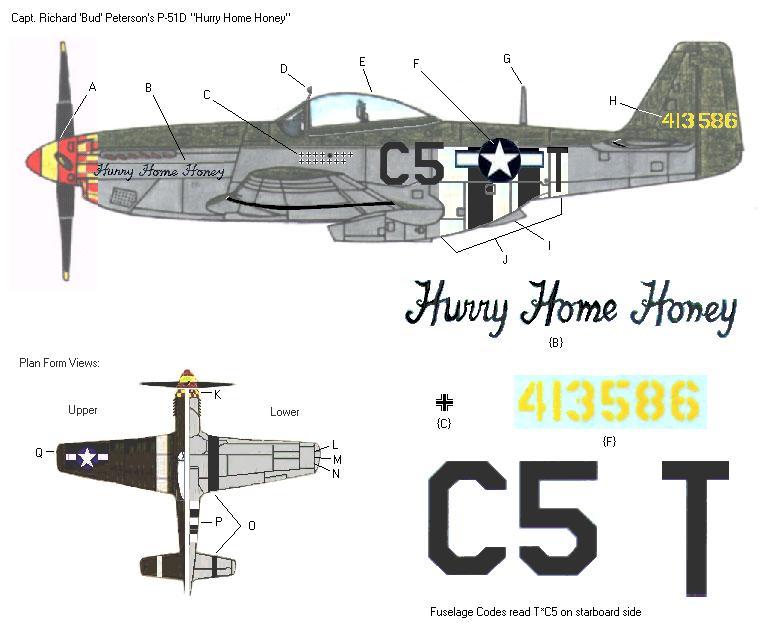357th FG Profile

Capt. Richard “Bud” Peterson’s P-51D Mustang “Hurry Home Honey”

Autumn /-Fall 1944
Modeler Tips:
Side View Notes:
A. Rear red band on propeller boss extends onto spinner to leading edge of blades when in neutral pitch. Determine width of yellow band by dividing remainder of spinner evenly.
B. “Hurry Home Honey” in black occupies lower-most strip panel beneath exhaust on port side, serifs on first “H” overlap rear row of checkers slightly. Most decal manufacturers print the lettering in black, but in some
photos it appears to have been red.
C. 14 kills, crosses fully bordered in white and black, two rows of seven- opening for signal pistol tube falls between crosses #4 & 5 in top row.
D. ETO half-sphere mirror, (standard part in most kits).
E. There were no antenna wires installed on this aircraft.
F. Decal manufacturers seem to disagree on size of insignia- in some photos it does appear to have been about 25% smaller than the 36 standard (although in some photos they look normal size to me). Modeler’s are advised to use their own discretion, check fuselage codes & insignia prior to adhesion to ensure proper arrangement.
G. Antenna post had bottom 4″ painted dark olive green, remainder natural metal.
H. Tail Number- “413” on fin, “586” on rudder in yellow.
I. Sides of radiator ventilation flap were natural metal.
J. Reduced invasion stripes come up to lower edge of uppermost panel seam.
Upper & Lower View Notes:
K: Width of checker reduced on underside in order to fit evenly on the narrow surfaces of the chin scoop area.
L, M, N. Red, Green, Yellow navigation lights- circular and flush with wing panel.
O. White (upper) and black (lower) recognition stripes were of standard widths on wings & stabilizers for mid-1944 ETO Mustangs.
P. Same as item J, above.
Q. Formation Lights- Red (Port) and Green (Starboard)
Overall Modeling Tips:
*This aircraft had olive drab upper surfaces, natural metal underneath. Paint on the flat colors first (recognition stripes, camouflage areas) first- then mask off and paint remainder a natural aluminum color. Most metal colors will be marred or removed by masking materials so it’s often better to leave them for last.
*After building several 357th A/C over the past 30 years, I recommend painting the nose area forward of the exhaust cutout yellow when the flat features are painted. Carefully cut away the yellow squares from the
checkerboard decal and apply the remaining strip of red checkers to the nose. This method significantly reduces the potential for bubbles and wrinkles, plus it makes exact alignment of the decal easier.
*Prior to assembly, wash clear plastic parts with a mild glass cleaner and gently wipe dry. Then use a Q-Tip to evenly spread clear liquid floor wax (Future Brand seems to get the best results) on both inside & outside.
Protect from dust and let dry for at least 2 hours. The wax fills in microscopic flaws and creates an even gloss that is clearer & shines brighter than the original plastic underneath.

